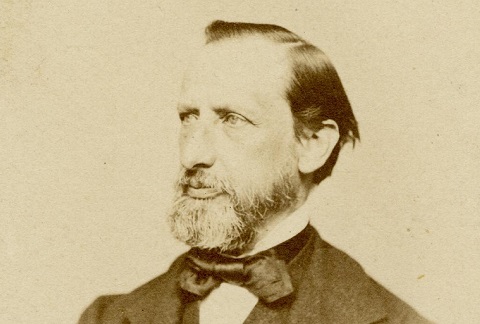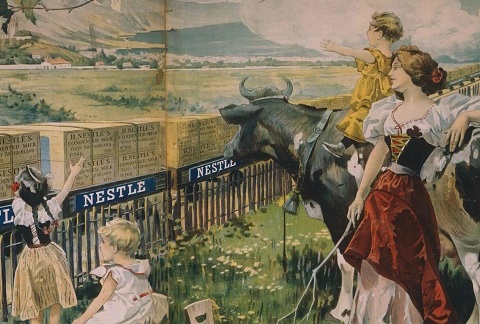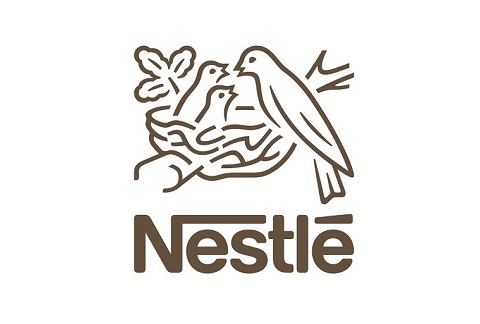The Nestlé company history

Navigate through the years to explore the highlights of the Nestlé story.
Our history begins in 1866, when the Anglo-Swiss Condensed Milk Company opens the first European condensed milk factory in Switzerland. Henri Nestlé develops a breakthrough infant food in 1867, and in 1905 the company he founded merges with Anglo-Swiss, to form what is now known as the Nestlé Group. During this period cities grow and railways and steamships bring down commodity costs, spurring international trade in consumer goods.
Highlights
1866

US brothers Charles and George Page help establish Anglo-Swiss Condensed Milk Company. Using abundant supplies of fresh milk in Switzerland, they apply knowledge gained in their homeland to establish Europe's first production facility for condensed milk in Cham. They start supplying Europe's industrial towns with the product under the Milkmaid brand, marketing it as a safe, long-life alternative to fresh milk.
1867

Nestlé's founder, German-born pharmacist Henri Nestlé, launches his 'farine lactée' ('flour with milk') in Vevey, Switzerland. It combines cow's milk, wheat flour and sugar, and Nestlé develops it for consumption by infants who cannot be breastfed, to tackle high mortality rates. Around this time he starts using the now iconic 'Nest' logo.
1875

Henri Nestlé sells his company and factory in Vevey to three local businessmen. They employ chemists and skilled workers to help expand production and sales.
1878

Fierce competition develops between Nestlé and Anglo-Swiss, when both companies start selling rival versions of the other's original products: condensed milk and infant cereal. Both firms expand sales and production abroad.
1882-1904

In 1882 Anglo-Swiss expands into the US, but the death of George Page frustrates its plans. In 1902 it sells its US-based operations, which paves the way for an eventual merger with Nestlé.
1904

Nestlé begins selling chocolate for the first time when it takes over export sales for Peter & Kohler. The Nestlé company also plays a role in the development of milk chocolate from 1875, when it supplies his Vevey neighbour Daniel Peter with condensed milk, which Peter uses to develop the first such commercial product in the 1880s.
In 1905, Nestlé & Anglo Swiss has more than 20 factories, and starts using overseas subsidiaries to establish a sales network that spans Africa, Asia, Latin America and Australia. As World War One approaches, the firm benefits from the period of prosperity known as the Belle Époque or 'Beautiful Age', and becomes a global dairy company.
Highlights
1905

Anglo-Swiss and Nestlé merge to form the Nestlé & Anglo-Swiss Milk Company. The company has two head offices, in Vevey and Cham, and opens a third office in London to drive dairy export sales. Over several years the company expands its range to include unsweetened condensed milk and sterilised milk.
The outbreak of war in 1914 leads to increased demand for condensed milk and chocolate, but a shortage of raw materials and limits on cross-border trade hamper production for Nestlé & Anglo-Swiss. To solve this problem, the company acquires processing facilities in the US and Australia, and by the end of the war it has 40 factories.
Highlights
1914

War breaks out across Europe and disrupts production for the company, but hostilities also drive demand for Nestlé dairy products, in the form of large government contracts.
1915

Condensed milk is long-lasting and easy to transport, which makes it popular with armed forces. For example, in 1915 the British Army starts issuing Nestlé canned milk to soldiers in their emergency rations. Strong demand for the product means that the company’s milk refineries are working flat out.
1916

Nestlé & Anglo-Swiss acquires Norwegian dairy company Egron, which has patented a spray-drying process for producing milk powder – a product its new owner starts selling.
1917-1918

Milk shortages in Switzerland mean that Nestlé & Anglo-Swiss has to surrender fresh milk supplies to help people in towns and cities. To meet demand for condensed milk from the warring nations, the company buys US refineries and signs supply agreements with Australian companies, which it later acquires.
After the war military demand for canned milk declines, causing a major crisis for Nestlé & Anglo-Swiss in 1921. The company recovers, but is rocked again by the Wall Street Crash in 1929, which reduces consumer purchasing power. However, the era carries many positives: the company's management corps is professionalised, research is centralised and pioneering products such as Nescafé coffee are launched.
Highlights
1921-1922

Falling prices and high stock levels lead to the first, and only ever, financial loss for Nestlé & Anglo-Swiss in 1921. Banker Louis Dapples joins as Crisis Manager, and encourages the company to appoint professional managers for the first time. Administration is centralised, and research is consolidated at one laboratory in Vevey, Switzerland.
1929

The company buys Switzerland's largest chocolate company Peter-Cailler-Kohler, the origins of which date back to 1819 when François Louis Cailler creates one of the country's first chocolate brands Cailler. Chocolate now becomes an integral part of the Nestlé & Anglo-Swiss business.
1934

Malted chocolate drink Milo is launched in Australia, and its success means it is later exported for sale in other markets. The company continues to develop baby and infant foods in this inter-war period, and launches Pelargon in 1934, a full-milk powder for babies enriched with lactic acid bacteria, to improve its digestibility.
1936

A competitive market for chocolate in Switzerland encourages Nestlé-Peter-Cailler-Kohler to innovate by launching Galak white chocolate and Rayon, a chocolate with honey and air bubbles, the next year. Vitamins are a major selling point for healthy products in the 1930s, and Nestlé launches vitamin supplement Nestrovit in 1936.
1938

Nescafé is launched as a 'powdered extract of pure coffee' that retains coffee's natural flavour, but can be prepared by simply adding hot water. The product is the brainchild of Max Morgenthaler, who begins work on it in 1929, when the Brazilian government asks Nestlé & Anglo-Swiss to find an outlet for its huge coffee surplus.
The outbreak of World War Two in 1939 affects virtually every market, but Nestlé & Anglo-Swiss continues to operate in difficult circumstances, supplying both civilians and armed forces. In 1947, the company adds Maggi soups and seasonings to its product range, and adopts the name Nestlé Alimentana.
Highlights
1939

Fearing that the Axis powers could occupy Switzerland, Nestlé & Anglo-Swiss relocates some managers to a new office in Stamford in the US, which operates as the company's second headquarters during the war. The fighting in Europe makes it impossible for Nestlé to export milk from there, so the company supplies Africa and Asia from the US and Australia, and expands production in Latin America.
1942-1945

World War Two initially slows sales of Nescafé, but they pick up as hostilities continue. After the US enters the war, Nestlé brands rapidly gain popularity among American service personnel. At the end of the war, Nescafé is also included in CARE aid supplies in Japan and Europe. Nestea is launched in the late 1940s.
1947

Nestlé & Anglo Swiss merges with Swiss company Alimentana, which produces Maggi soups, bouillons and seasonings, and is renamed Nestlé Alimentana. Alimentana's history dates back to 1884, when Julius Maggi developed a protein-rich dried soup to tackle malnutrition.
The post-war period is marked by growing prosperity, and people in the US and Europe spend money on machines that make life easier, such as refrigerators and freezers. They also favour convenience foods, and Nestlé Alimentana meets this need with new products including Nesquik and Maggi ready meals.
Highlights
1948

In the US Nestlé Alimentana launches a soluble tea, Nestea, which is manufactured using the same method as Nescafé, and can be served both hot or cold. Nesquik, which dissolves easily in cold milk, is also launched in the US and becomes a top seller.
1954

Nestlé infant cereal has been available since 1948 as a powdered product, but it is now rebranded as Cerelac. Originally only sold as a bouillon cube, Maggi seasoning brand Fondor is launched as a powder. Packaged in a convenient shaker, it can now be used as a condiment in the dining room, as well as in the kitchen.
1957
Canned ravioli is launched under the Maggi brand. Its huge success prompts Nestlé to launch more canned, prepared foods, which become a new growth segment.
Acquisitions enable Nestlé to enter fast-growing new areas such as frozen foods, and to expand its traditional businesses in milk, coffee and canned foods. In the 1970s the company diversifies into pharmaceuticals and cosmetics. It starts to attract criticism from activist groups that allege its marketing of infant food is unethical. Nestlé later becomes one the first companies to apply the WHO code on breast-milk substitutes across its business.
Highlights
1960

With increasing numbers of households buying freezers, demand for ice cream is rising. Nestlé buys German producer Jopa and French manufacture Heudebert-Gervais to capitalise on this growth, and adds Swiss brand Frisco in 1962. The company also buys UK canned foods company Crosse & Blackwell.
1962

Nestlé buys the Findus frozen food brand from Swedish manufacturer Marabou, and extends the brand to international markets. Findus is one of the first companies to sell frozen foods in Europe, from 1945.
1968
Chilled dairy products are increasingly popular, Nestlé buys French yogurt producer Chambourcy. In the early 1970s the latter launches the Sveltesse range of yoghurts, aimed at health- and weight-conscious consumers.
1969
Nestlé enters mineral waters by buying a stake in French waters brand Vittel.
1973

Keen to bolster its canned foods and frozen portfolio in Anglo-Saxon markets, Nestlé takes over the US frozen foods company Stouffer Corporation, and buys canned foods producer Libby, McNeill & Libby in 1976.
1974
For the first time, Nestlé diversifies beyond food and drink, becoming a minority shareholder in global cosmetics company L'Oréal.
1977
Renamed Nestlé S.A, the company continues its diversification strategy, buying US pharmaceutical and ophthalmic products manufacturer Alcon Laboratories. Declining breast-feeding rates lead some activists to question the baby food marketing strategies of companies including Nestlé. In 1977 they call on people to boycott Nestlé products.
Following years of growth, Nestlé disposes of unprofitable brands and promotes those that satisfy increasingly health conscious consumers, in line with its new 'Nutrition, Health and Wellness' ambition. The company expands in the US, Eastern Europe and Asia, and targets for global leadership in water, ice cream and animal food.
Highlights
1981
Stouffer's Lean Cuisine frozen meals are launched on a low-fat, low-calorie platform, and the brand posts impressive sales. Nestlé and L'Oreal establish Galderma as a joint venture active in dermatology. The World Health Assembly adopts the WHO code on breast-milk substitutes, and Nestlé is one of the first companies to develop policies based on it and apply them across its business.
1985

By acquiring US-based Carnation Company for USD 3 billion, Nestlé adds brands such as Carnation and Coffee-Mate to its portfolio. It also enters the pet food business when it buys the Friskies brand.
1986

The Nespresso story begins with a simple idea: enable anyone to create a perfect cup of coffee, just like a skilled barrista.
1988

Nestlé buys UK confectionery company Rowntree Mackintosh, adding brands including KitKat, After Eight and Smarties to its portfolio. It also acquires Italian pasta, sauce and confectionery group Buitoni-Perugina.
1991
Nestlé establishes a joint venture with General Mills, Cereal Partners Worldwide, to produce and market breakfast cereals globally. The company also creates a joint venture with The Coca-Cola Company to form Beverage Partners Worldwide, to manufacture and market brands including Nestea.
1992

Nestlé develops its position in mineral waters by acquiring France's Perrier Group. Nestlé Sources Internationales is created as a separate waters business in 1993, and is renamed Nestlé Waters in 2002.
1997
New CEO Peter Brabeck-Letmathe sees growth potential in personalised nutrition. He articulates Nestlé's position as the leader in 'Nutrition, Health and Wellness', as the millennium approaches.
1998

Nestlé buys Italian mineral waters business Sanpellegrino Group. Nestlé Pure Life is launched in developing countries, to guarantee clean and healthy drinking water, and Aquarel is launched in Europe two years later.
2000

The Sustainable Agricultural Intiative Nestlé (SAIN) is launched to promote collaboration with local farmers. It aims to improve their living standards and ensure a sustainable supply of commodities.
2001

Nestlé buys US pet food business Ralston Purina, and merges it with Nestlé Friskies Petcare to establish the new market leader in pet care, Nestlé Purina Petcare.
2002

After expanding its ice-cream business in the 1990s, Nestlé acquires the licensing rights to premium producer Häagen-Dazs in the US and Canada, and buys Mövenpick and Dreyer's Grand Ice Cream in 2003. It also acquires frozen foods business Chef America for USD 2.6 billlion.
Nestlé articulates its Creating Shared Value approach to business for the first time, and launches its Nestlé Cocoa Plan and Nescafé Plan to further develop sustainable supply chains in cocoa and coffee. While strengthening its position in traditional segments, infant formula and frozen foods, Nestlé strengthens its focus on medical nutrition.
Highlights
2006
Nestlé articulates its Creating Shared Value approach to doing business, whereby any action for shareholders must also create value for the communities where it operates and wider society. Nestlé acquires weight management business Jenny Craig and Australian breakfast cereals company Uncle Toby's.
2007
A growing focus on medical nutrition leads Nestlé to the acquire Novartis Medical Nutrition. It also buys baby food company Gerber and Swiss mineral waters concern Sources Minérales Henniez.
2009

The first Creating Shared Value Forum in New York brings together experts to discuss global challenges in the areas of nutrition, water and rural development, and the role of business in helping to solve them. The Forum becomes an annual event. Nestlé creates a foodservice business division, named Nestlé Professional from 2009.
2010

Nestlé acquires Kraft Foods' frozen pizza business. The Nestlé Cocoa Plan and Nescafé Plan are both launched to develop the company's sustainable supply chains in cocoa and coffee, improve social conditions in farming communities, and ensure their profitability.
2011

Nestlé Health Science and the Nestlé Institute of Health Sciences are established, to research science-based nutritional products aimed at preventing and treating chronic medical conditions. Nestlé becomes the first food company to work with the Fair Labor Association (FLA), to help tackle child labour in the cocoa supply chain.
2012
Nestlé acquires Wyeth Nutrition, formerly Pfizer Nutrition, for USD 11.9 billion, to strengthen its position in infant nutrition.
2013
Nestlé Health Science buys US-based medical foods company Pamlab, which specialises in medical nutrition for patients with conditions including mild cognitive impairment and depression. Weight management business Jenny Craig is sold in America and Oceania.
2014

With the creation of Nestlé Skin Health, Nestlé takes full control of the Galderma dermatology joint venture which it created with L'Oréal in 1981. The companies also end their joint venture Innéov, a cosmetic nutritional supplements business launched in 2002. Galderma subsequently acquires some of its assets.
2015

Nestlé launches Cailler, the oldest surviving Swiss chocolate brand, as its first super-premium global chocolate. French frozen foods business Davigel is sold.
2016
Nestlé celebrates its 150 year as a company. A portion of the ice cream, frozen food and chilled dairy business is incorporated into a joint venture – Froneri – with UK ice cream manufacturer R+R.
2017
Nestlé announces that it will explore strategic options for its US confectionery business and extends its consumer healthcare portfolio with the acquisition of Atrium Innovations. The move supports Nestlé's pursuit of growth opportunities in consumer healthcare, complements the company's focus on high-growth food and beverage categories such as coffee, petcare, infant nutrition and bottled water. US investments are also made in Chameleon Cold–Brew coffee, Blue Bottle Coffee, Sweet Earth and Freshly.
2018
Nestlé and The Coca-Cola Company end their Beverage Partners Worldwide joint venture.
2019
Nestlé inaugurates the Nestlé Institute of Packaging Sciences. The company closes the sale of Nestlé Skin Health. Nestlé sells its U.S. ice cream business to Froneri in a strategic move to create global leader in ice cream. The company sells 60% of its stake of Herta and creates a joint venture with Casa Tarradellas.
2020
Nestlé Health Science expands its portfolio through the acquisition of Zenpep, Vital Proteins and Aimmune. Yinlu peanut milk and canned rice porridge businesses are sold. The company launches its Net Zero Roadmap.
2021
Nestlé continues strategic transformation of the water business with the sale of Nestlé Waters North America brands and is entering the functional hydration segment with the acquisition of Essentia and Nuun. Nestlé Health Science expands its portfolio through the acquisition of the core brands of The Bountiful Company. Nestlé reduces its stake in L'Oréal. The company sharpens geographic focus, creates Zones North America and Greater China. Nestlé’s regeneration efforts are launched under the umbrella of 'Generation Regeneration'.





